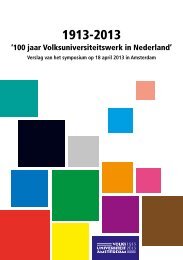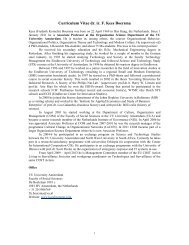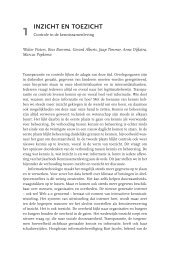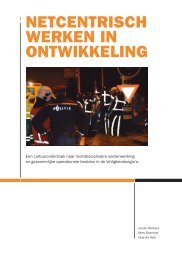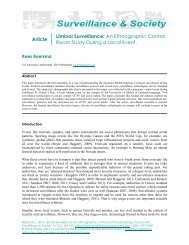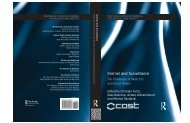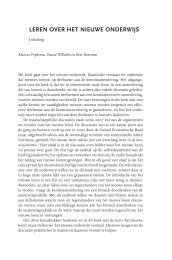Access article in PDF - Project MUSE - Johns Hopkins University
Access article in PDF - Project MUSE - Johns Hopkins University
Access article in PDF - Project MUSE - Johns Hopkins University
You also want an ePaper? Increase the reach of your titles
YUMPU automatically turns print PDFs into web optimized ePapers that Google loves.
74 BOERSMA<br />
for his researchers. Weekly colloquia and encouragement to publish<br />
their research f<strong>in</strong>d<strong>in</strong>gs were important to the <strong>in</strong>dustrial scientists.<br />
By improv<strong>in</strong>g and further develop<strong>in</strong>g <strong>in</strong>candescent lamps, the<br />
Physics Laboratory accomplished its orig<strong>in</strong>al mission, but a further<br />
goal was to obta<strong>in</strong> more patents and to assist <strong>in</strong> the company’s diversification<br />
process. Only after the management decision to diversify<br />
its product portfolio did research activities at the Physics Laboratory<br />
expand and Holst’s scope broaden. In 1923 Philips decided to establish<br />
a new laboratory build<strong>in</strong>g with modern equipment, plenty of<br />
workspace, and a Pilot Factory to facilitate the company’s ambitions<br />
to expand its product scope. Holst now had the resources at his disposal<br />
to carry out the new research activities that Philips demanded.<br />
Highly educated Physics Laboratory employees provided Philips<br />
with the technical expertise, patents, and new products it required.<br />
After 1925, with Philips established <strong>in</strong> an <strong>in</strong>ternational lamp cartel,<br />
Anton Philips was free to look for new markets. 26<br />
Radiology technology was only one new area of Philips research,<br />
but the X-ray tube was one of the first new products the laboratory<br />
researchers had tackled, and the Physics Laboratory’s X-ray activities<br />
were an important first step <strong>in</strong> a new direction toward the diversification<br />
of Philips. Knowledge and skills developed dur<strong>in</strong>g electron<br />
tube research equipped the Philips staff well for this work, which<br />
opened up a completely new market for Philips. The Philips researchers<br />
did not spontaneously develop X-ray technology; it found<br />
its way <strong>in</strong>to the Physics Laboratory <strong>in</strong> a roundabout way. In 1917,<br />
echo<strong>in</strong>g Wertheim Salomonson, Dutch physicians drew attention to<br />
the fact that the war was jeopardiz<strong>in</strong>g the supply of X-ray tubes and<br />
equipment to the Netherlands. 27 When Germany stopped supply<strong>in</strong>g<br />
X-ray equipment, doctors enlisted Philips for repair and ma<strong>in</strong>tenance,<br />
because X-ray tubes bore many technical similarities to light<br />
bulbs. The next year found Wertheim Salomonson express<strong>in</strong>g relief<br />
over Philips’s entrance <strong>in</strong>to the radiology market. 28<br />
26. Ivo J. Blanken, The History of Philips Electronics N.V., vol. 3: The Development<br />
of N.V. Philips’ Gloeilampenfabrieken <strong>in</strong>to a Major Electrical Group (Zaltbommel,<br />
1999), especially chap. 3, “The Phoebus International Incandescent Lamp<br />
Cartel.” This Swiss corporation set the rules, controlled prices, regulated sales,<br />
implemented policy, and established a test<strong>in</strong>g laboratory to ensure the product<br />
quality of its members. See Geoffrey Jones, The Evolution of International Bus<strong>in</strong>ess:<br />
An Introduction (London, 1996), chap. 4, “National Manufactur<strong>in</strong>g.”<br />
27. PCA 815.1 Röntgen; Blanken, History of Philips Electronics, 217; and Albert<br />
Bouwers, “Natuurwetenschappelijk Onderzoek <strong>in</strong> de Industrie” [Applied Scientific<br />
Research <strong>in</strong> Industry] De Ingenieur 29 (July 1946): A284.<br />
28. M<strong>in</strong>utes of the 33d Annual Meet<strong>in</strong>g of the NVER, <strong>in</strong> Nederlands Tijdschrift<br />
voor Geneeskunde 62 (1918): 1733.



